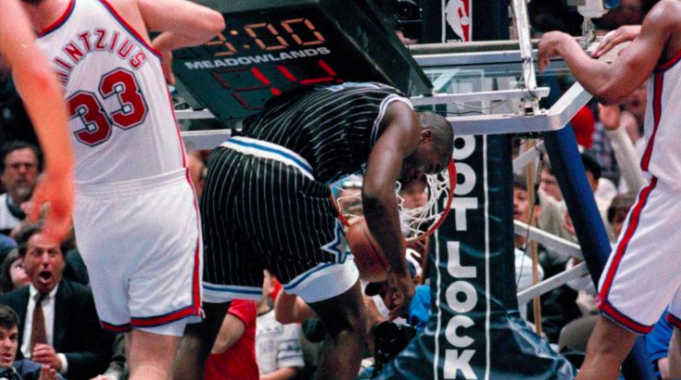Since it’s Shaq Week on NBA TV this week, I figured this little flashback would fit right in.
In the 90s, when I was an early teenager who thought he was Michael Jordan, I used to love going to the closest elementary school to have a dunk contest with my friends. In my case, that was Linda Vista in San Jose, CA. I had an adjustable rim in my backyard, and I would practice my dunks every day after school. When the weekend rolled around, we would go there because the rims were only eight feet high and we could dunk, or we would go to St. John’s down the street to hoop. Those rims were a little over nine feet high, so the games there would get pretty high-flying by older guys. That was the time of And1, Hoop It Up, and betting on 2-on-2 games like in White Men Can’t Jump. It was all about the soft-touch, reverse layup, the tongue-sticking-out type of hang time, and it was all about breaking backboards. Trust me when I say that, in the 90s, it was all about the dunk.
In fact, it was so much about the dunk that the term “posterized” was developed in the 90s because of this era of hoop. If you’re unfamiliar with that term, here’s some quick game for you. A person gets posterized when a player dunks the ball over them, someone takes a picture of it, and blows it up to be a poster for the player who did the dunking. When it came to posterizing other guys in style, it really all began with Julius “Dr. J” Erving and evolved into dunkers like Shawn Kemp, Clyde “The Glide” Drexler, Dominique Wilkins, and his Airness, Michael “Air” Jordan. Power dunks, on the other hand, were something completely different; they hurt people and broke stuff.
Power dunks gave the posterized players black eyes, broken noses, and demoralized egos. For these kinds of dunks, I think about Darryl Dawkins, Charles Barkley, Patrick Ewing, and none other than Shaquille O’Neal, aka Shaq, aka Shaq Fu, aka The Big Cactus, aka The Big IPO. Shaq was such a beast when he came into the league in 1992 that he’s the reason why most high schools and colleges have breakaway rims and shatterproof backboards in their gyms now.
I still remember one of the first looks I got at Shaq. It was during an Inside Look segment, before the 1992 NBA draft, when he played a 1-on-1 game against the host Ahmad Rashad. Ahmad gave him a few quick moves and took him to the cup a few times during the segment, but he missed and Shaq got the rock. He dribbled past Ahmad, gave him a juke, spun around him, rose high above the rim with the ball cocked behind his head, and dunked the ball so hard that it he yanked the rim off the backboard. Shaq went flying on to his back, getting showered by the glass from the backboard. I think the camera even shook when he hit the ground.
As a young basketball fanatic, I knew he would get drafted to the league in the first round, especially after that Ahmad-Rashad-Posterizing, rim-breaking, backboard-shattering, glass-dodging interview on the highest rated basketball show at the time, Inside Look. During Shaq’s rookie season in 1993, he broke two more backboards during live games: against the Phoenix Suns and against the New Jersey Nets (now the Brooklyn Nets). On top of that, he won the Rookie of the Year award. He had everybody hanging on the rim, trying to break it off. That’s exactly what I tried to do in my backyard every day after school. My five-foot, ninety-pound frame would rise up to the eight-foot rim like Mike and then hang on the rim like Shaq. I thought I had bounce.
I became such a little dunker on the eight-foot rim at fourteen years old that I tried to dunk over two of my buddies, Ronald and Steve, at the same time. I had just beaten them both in a dunk contest, and we were clowning (capping, burning, or roasting) on each other. That’s when I told them that I could dunk over both of them. They jumped up from their seats, waving their arms in the air in protest to my boast. I backed up, dribbling the ball between my legs as I back pedaled slowly, still selling tickets to the show I was about to put on. I reached the end of the concrete and yelled, “You ready?” They responded in tandem, “Yeah!” I made the ball spin backwards when I tossed it in the air so it would come back to me after it bounced. I took a few dribbles as I ran up on them. I picked up my dribble, took my two steps, and when I jumped, I thought of going over both of them with a Shaq-like one-handed jam. Instead, Ronald grabbed my elbow and Steve stopped me at the rim. I fell on my back like Shaq during the Inside Look interview, but instead of breaking the rim, I broke my wrist when I tried to break my fall. Breaking my arm was sort of a blessing. It gave me more time to watch basketball and study more moves.
Unfortunately, fantasy basketball wasn’t around then, but kids still had a way of keeping track of players through trading cards like Topps, Fleer, and Upper Deck, and magazines like Sports Illustrated, and by watching the games live on TV. I still remember watching Shaq and the Orlando Magic beat the Chicago Bulls (without Jordan) in the Eastern Conference Semifinals in 1995. Shaq had been in the league for about three years at that point (the Orlando Magic had only been in the NBA six years). They teamed Shaq up with Penny Hardaway, Nick Anderson, and Horace Grant. If you know anything about 90’s basketball, then you know that Horace Grant had just received three rings with the Chicago Bulls before he made the move to Orlando—after Jordan retired.
“In that split-second all the pieces came together and my role as leader was just as it should be: invisible” (Phil Jackson, Sacred Hoops Revisited, 2006).
The Magic ended that season by getting swept in the NBA Finals by Hakeem Olajuwon, Clyde Drexler, and the rest of the Houston Rockets. When Jordan came out of retirement, however, he went on to win another threepeat behind Phil Jackson. A few years later, Jordan left the Bulls to sign with the Washington Wizards after Phil Jackson decided to leave the Bulls in 1999. That was the end of the reign of the Bulls. Phil Jackson, however, signed with the Los Angeles Lakers, who were about to pick up Shaquille O’Neal to team him up with Kobe (the upgrade from Penny), and, well, we all know how that story ended. What’s it with Phil Jackson and threepeats?
In the 90s, it was all about the dunk, and even though I didn’t get a chance to dunk like Jordan or Shaq on regulation when I was young, I still hooped. I still do and I still love this game.

